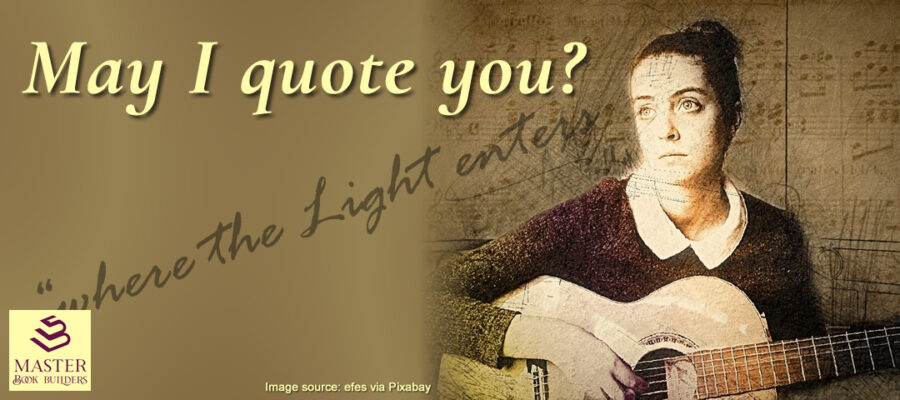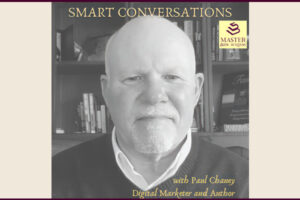Marginalia: May I Quote You?
This episode of Marginalia delves into the messy, confusing world of copyright law and our “fair use” right to use extracts from others’ work without permission. I’ve written and presented workshops on fair use before, so I hope you’ll forgive me quoting myself, as I try to help you gain some comfort in analyzing when you can quote others.
The topic came up again for me as we were putting the finishing touches on I Am Perfectly Flawsome, when one of our beta readers noted the quotation from Leonard Cohen’s song, Anthem, and warned of their understanding that fair use “rarely” applies to song lyrics.
Because this feedback came from an experienced author, it gave me pause to look a little deeper. (Yes, I should have thought of it myself, but I’m grateful for the nudge!)
Here’s how the saga unfolded.
How Much Is Too Much?
As you may be aware, the music industry is notoriously litigious, often claiming infringements over a few notes or words. I’ve long thought they were out of their minds to spend so much energy suing their fans (remember Napster?) and each other.
But my core disagreement is with the notion I’ve seen argued in online forums and industry statements that song lyrics are somehow different and can never be quoted under fair use. As one author (with a law degree) wrote, after noting the common negative advice:
“So the first thing to note is that there is no statute or court decision that exempts song lyrics from fair use. Zip.”
Which puts us back in the morass of court decisions that are all over the place on how fair use applies to any specific situation. The real problem with using song lyrics, or lines of poetry, comes from the fact that most songs and poems are fairly short. So taking even a few lines may well be a substantial part of the whole song.
That prompted me to look up the full song lyrics. The part we had intended to quote was only 23 words, though it turns out two of those words are repeated in Cohen’s performance. How does that play, when the whole song is only 261 words?
Now, another “rule” of fair use that you’ll see all over the internet is that you can safely quote up to 10% of a work. That would put us just below the limit and safe, right?
The problem remains that there is no such rule in copyright law. Instead, the courts wander through analyzing the “four factors” laid out in the U.S. Copyright Act, Section 107:
“… the fair use of a copyrighted work, … for purposes such as criticism, comment, news reporting, teaching (including multiple copies for classroom use), scholarship, or research, is not an infringement of copyright. In determining whether the use made of a work in any particular case is a fair use the factors to be considered shall include—
- the purpose and character of the use, including whether such use is of a commercial nature or is for nonprofit educational purposes;
- the nature of the copyrighted work;
- the amount and substantiality of the portion used in relation to the copyrighted work as a whole; and
- the effect of the use upon the potential market for or value of the copyrighted work.”
It’s number three that gets us into the “how much” question and it’s clearly not just a numbers game. The statute asks us to look at not just the “amount” but also the “substantiality” of the portion being used.
And that’s where I concluded that our use probably would not have been fair use. I had originally found the quote excerpted on a quote list about perfectionism, perhaps on Goodreads, though I don’t recall now. Here’s what I found and we had planned on using as a chapter quote:
“Ring the bells that still can ring
Forget your perfect offering
There is a crack in everything
That’s how the light gets in”
— Leonard Cohen, Anthem
What I discovered on looking at the whole song was that those lines are the chorus of the song. And they’re repeated four times, plus the last line is repeated twice more at the end.
That meant I was arguably looking at 112 words out of the 261, as the song was performed by Cohen. That’s 43%. Plus, it’s the chorus, which would likely be viewed as “the heart of the work” — a phrase often seen in court opinions discussing the “substantiality of the portion used.”
Since we still would have liked to use the quote in the book, I took the time (often an impenetrable barrier) to track down the person listed on Cohen’s website for getting permission and reached out with our request.
Three times.
Silence. Again, a common experience.
In the end, we decided to remove the quote from the book before publishing. More about what we used instead in a moment.
The Other Fair Use Factors
You might be asking why I’m using it here. In short, factors 1 and 4.
The main reason is factor 1, the purpose and character of the use here. The statute goes out of its way to favor fair use when the purpose is for “criticism, comment, … teaching” and especially “for nonprofit educational purposes.”
While you’ll be the judges of how well I’m succeeding, my main purposes here are to comment on the vagaries of fair use law.
And to teach you a bit about how to apply it, using our experience with this piece of song lyrics as our example. As I mentioned, song lyrics and poetry are particularly knotty problems for fair use analysis and it was useful to give you the actual example that led me to write about it.
For the gentle criticism part, I’ll explain how Cohen’s chorus lyrics and his representative’s silence play into some of my past writings on the topic.
Is It Original?
One of my criticisms of the way the music industry so agressively claims ownership of ever-smaller snippets of sound and words goes to the very notion of originality that underlies copyright law. As I wrote a few years ago:
“For me, it’s a simple, biological reality that every idea you, or I, or Isaac Newton ever conceived and attempted to communicate was built on uncountable bits of other peoples’ work. By the time we emerge from the womb, we’ve already been absorbing information into our brains. We never stop taking in more and connecting the bits together.
“When we express these connections in words, images, sounds, or actions, the result may be beautiful and pleasing to others. But there’s nothing original about it.”
Look again at Cohen’s lyrics about how it’s the cracks that let the light in. Now look at this quote from Rumi, who lived and wrote some 800 years ago:
“The wound is the place where the Light enters you.”
I don’t know if Cohen ever read that quote, or if he heard the concept from someone else’s riff off of it. But although I don’t mean to belittle the beauty of his precise wording — we loved it enough to want to quote him — the similarity is striking.
I suspect if Rumi were a contemporary musician with a song predating Anthem and using that line as the hook, he’d have music industry lawyers lining up to sue Cohen.
But Rumi’s work is long since in the public domain, so we (and Cohen) are free to use it without worry.
Find the Fair Use Best Practices Code that Fits Your Work
In another blog post from my BlogPaws days, I wrote about a movement by creatives in a variety of genres, film, journalism, teaching, and more, to agree on codes of Best Practices for Fair Use that spoke to the individual needs of both creators and copyright owners.
While they are not law and do not bind the courts to follow them, I believe they provide useful ways of thinking about the problem from both sides, the creators seeking to build on our collective learning and those seeking to protect what they’ve produced already.
Those who are creating will soon find themselves on the other side. Most of us live on both sides all the time. The balancing of the rights and responsibilities between them is what fair use really comes down to.
I suggested in that BlogPaws post that you study some of the Best Practices Codes and that my own study of them had given me a way of thinking about fair use that I captured in the phrase, “Yes/No, Plus!” Here’s how I fleshed that out:
“Am I quoting something to show my agreement with it? “Yes.” Am I adding my own explanation and expanding on the quoted excerpt? “Plus!”
“Am I quoting to express my questioning or disagreement? “No.” Am I adding something to show why I doubt or disagree? “Plus!” The exclamation point purposefully reminds me that my own commentary or criticism — the value or knowledge I’m adding — should be the main reason for quoting in the first place.
“When I’m thinking through the details of how my use may fit into one or more of the “situations” covered in the best practice codes, I put to Yes/No, Plus! question to myself this way:
“Does my use qualify as comment or criticism by fitting one of these patterns? —
- Yes, and …
- Yes, because …
- Yes, but …
- Yes, if …
- No, and …
- No, because …
- No, but …
“The answer isn’t always going to fit neatly or precisely into one slot. But I hope you can see the value in thinking through the answers as an essential part of your work.”
I never said it would be easy. But I hope this helps you feel a little more comfortable in exercising your right to fair use. For me, it’s also a responsibility to keep building our collective knowledge by “standing on the shoulders of giants” — which often requires quoting them to be effective!
That’s why the courts found it essential to create the fair use exception in the first place.






Leave a Reply